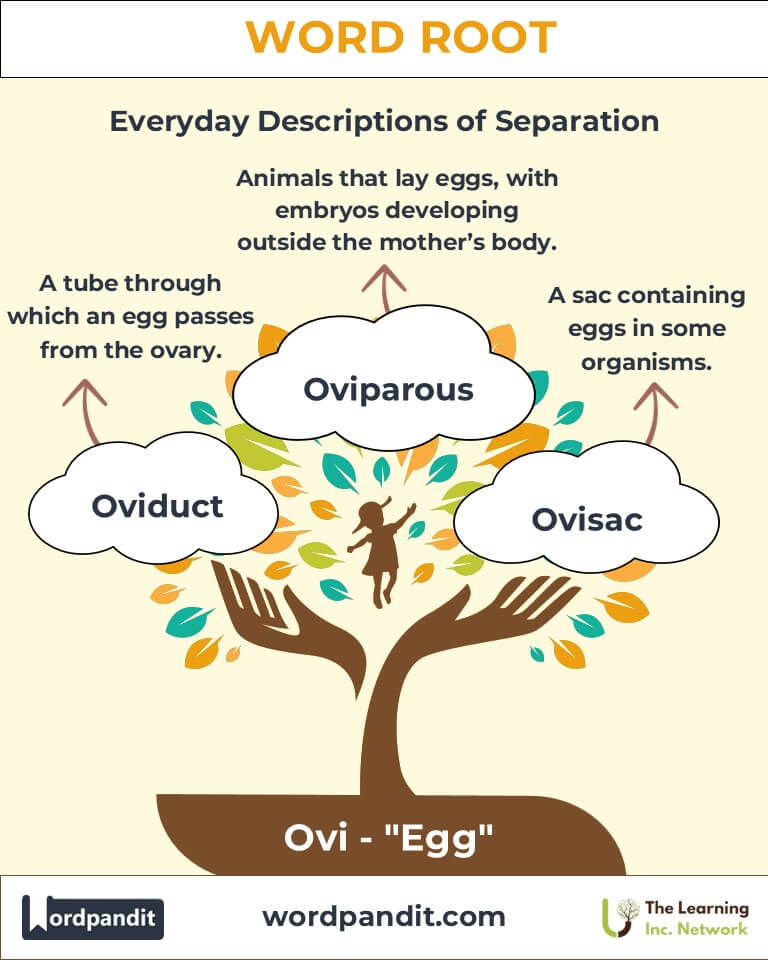Ovi: Unlocking the Meaning of Life Through Language
Delve into the fascinating root Ovi, derived from Latin, meaning egg. This linguistic gem enriches scientific and everyday language, symbolizing beginnings and fertility. From terms like oviduct to oviparous, explore how this root embodies life’s potential across disciplines.

Table of Contents
- Introduction: The Origin of Ovi
- Etymology and Historical Journey
- Mnemonic: Unlocking the Power of Ovi
- Common Ovi-Related Terms
- Ovi Through Time
- Ovi in Specialized Fields
- Illustrative Story: Ovi in Action
- Cultural Significance of the Ovi Root
- The Ovi Family Tree
- FAQs about the Ovi Root
- Test Your Knowledge: Ovi Mastery Quiz
- Conclusion: The Living Legacy of Ovi
Introduction: The Origin of Ovi
The word root Ovi, pronounced "oh-vee," stems from Latin, meaning egg. It forms the foundation of terms central to biology and reproduction, symbolizing origins and beginnings. From oviducts guiding eggs in anatomy to oviparous creatures laying eggs, Ovi represents the cycle of life.

Etymology and Historical Journey
The root Ovi originates from the Latin ovum, meaning egg. Ancient Roman and Greek scholars used it to describe reproduction, highlighting its foundational role in life sciences. Over centuries, this root has remained prominent in scientific terminology, reflecting humanity’s enduring fascination with life’s origins.
Mnemonic: Unlocking the Power of Ovi
Imagine a golden egg radiating light, symbolizing life’s beginning. This vivid image ties the root Ovi to its meaning.
Mnemonic Device:
"Ovi opens the origins of life, from eggs to evolution."
Common Ovi-Related Terms
- Oviduct (oh-vee-dukt):
Definition: The tube through which an egg passes from the ovary.
Example: "The oviduct plays a crucial role in fertilization in many species." - Oviparous (oh-vip-uh-ruhs):
Definition: Animals that lay eggs, with embryos developing outside the mother’s body.
Example: "Chickens are oviparous, laying eggs that hatch into chicks." - Ovisac (oh-vee-sak):
Definition: A sac containing eggs in some organisms.
Example: "The ovisac in amphibians protects the eggs until they hatch." - Oviform (oh-vee-form):
Definition: Egg-shaped.
Example: "The artist sculpted an oviform design to symbolize birth." - Ovulation (ov-yoo-lay-shun):
Definition: The release of an egg from the ovary.
Example: "Ovulation is a key process in mammalian reproduction."
Ovi Through Time
- Ovum (Classical Usage): Originally described as the seed of life in ancient texts.
Shift: From philosophical metaphors to biological science. - Ovipositor (Modern Science): An egg-laying structure in insects.
Impact: Expanded the root’s use to include entomology.
Ovi in Specialized Fields
- Anatomy:
Oviduct: Critical for understanding reproductive systems in vertebrates. - Zoology:
Oviparous: Helps classify species based on reproductive methods. - Paleontology:
Oviraptor: A dinosaur whose name means "egg thief," highlighting fossilized egg studies. - Art and Design:
Oviform: Represents themes of fertility and origin in sculptures and designs.
Illustrative Story: Ovi in Action
In a remote conservation center, Dr. Lin studied oviparous sea turtles. Each evening, she carefully observed their journey to lay eggs in sandy nests. One night, a young girl, curious about the process, asked, “Why do turtles lay eggs?” Dr. Lin explained the role of oviducts and the importance of protecting oviparous species. Inspired, the girl pledged to protect the nests, ensuring the cycle of life continued.
Cultural Significance of the Ovi Root
Eggs symbolize fertility, rebirth, and creation across cultures. From the cosmic egg in Hindu mythology to the Fabergé eggs of Russia, the root Ovi transcends biology, embedding itself in art, tradition, and spirituality.

The Ovi Family Tree
- Ov- (Egg):
- Ovule: A plant structure that develops into a seed.
- Ovary: The organ producing eggs in animals and plants.
- Ovi- (Prefix):
- Ovipositor: An egg-laying appendage in insects.
- Ovi-/Ovul-:
- Ovular: Relating to an ovule or egg.
FAQs About the Ovi Word Root
Q: What does "Ovi" mean?
A: "Ovi" means egg and is derived from the Latin word "ovum." It is commonly used in biology and zoology to describe structures, processes, or organisms related to eggs, such as "oviduct" (egg-transporting tube) or "oviparous" (egg-laying animals).
Q: What is the function of an oviduct?
A: The oviduct is a tube that transports eggs from the ovary to either the uterus (in mammals) or the external environment (in egg-laying animals). In birds and reptiles, this tube also supports fertilization and the deposition of protective egg layers like shells.
Q: What does "oviparous" mean, and how does it differ from "viviparous"?
A: "Oviparous" refers to animals that lay eggs, with embryos developing outside the mother's body, such as birds, reptiles, and amphibians. In contrast, "viviparous" animals give birth to live young, with the embryo developing inside the mother's body, as seen in mammals.
Q: What does "oviform" describe?
A: "Oviform" means egg-shaped and is used to describe objects or structures resembling an oval or egg. It is common in design, art, and science to denote shapes associated with fertility and new life.
Q: What is ovulation, and why is it important?
A: Ovulation is the process by which an egg is released from the ovary in mammals. It is crucial for reproduction, as the released egg can be fertilized by sperm to form an embryo. Ovulation is regulated by hormones and is a key part of the menstrual or estrous cycle.
Q: Are all egg-laying animals oviparous?
A: Yes, oviparous animals lay eggs with embryos developing externally. However, some oviparous species, like certain fish and amphibians, may provide protection or care for their eggs, while others, like birds, incubate them.
Q: What is an ovisac, and how does it function?
A: An ovisac is a sac-like structure that contains eggs in certain organisms, such as amphibians and insects. It serves as a protective environment for eggs, ensuring they remain safe until they are laid or hatched.
Test Your Knowledge: Ovi Word Root Quiz
1. What does the root "Ovi" mean?
2. What is an oviduct?
3. Which term describes egg-laying animals?
4. What is ovulation?
5. What does oviform mean?
Conclusion: The Living Legacy of Ovi
The root Ovi symbolizes life’s origins, connecting language to biology, art, and culture. As science advances, this root will continue to enrich our understanding of reproduction and creation. Let Ovi remind us of the delicate beginnings of life, inspiring us to protect and cherish its wonders.












